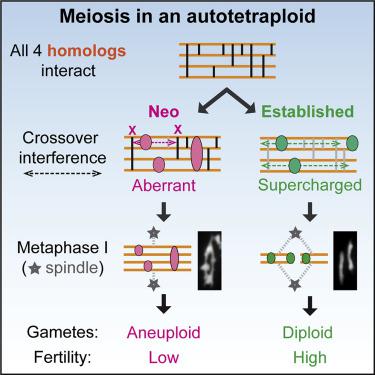Current Biology ( IF 8.1 ) Pub Date : 2021-09-03 , DOI: 10.1016/j.cub.2021.08.028 Chris Morgan 1 , Martin A White 2 , F Chris H Franklin 3 , Denise Zickler 4 , Nancy Kleckner 2 , Kirsten Bomblies 1

|
Polyploidy is a major driver of evolutionary change. Autopolyploids, which arise by within-species whole-genome duplication, carry multiple nearly identical copies of each chromosome. This presents an existential challenge to sexual reproduction. Meiotic chromosome segregation requires formation of DNA crossovers (COs) between two homologous chromosomes. How can this outcome be achieved when more than two essentially equivalent partners are available? We addressed this question by comparing diploid, neo-autotetraploid, and established autotetraploid Arabidopsis arenosa using new approaches for analysis of meiotic CO patterns in polyploids. We discover that crossover interference, the classical process responsible for patterning of COs in diploid meiosis, is defective in the neo-autotetraploid but robust in the established autotetraploid. The presented findings suggest that, initially, diploid-like interference fails to act effectively on multivalent pairing and accompanying pre-CO recombination interactions and that stable autopolyploid meiosis can emerge by evolution of a “supercharged” interference process, which can now act effectively on such configurations. Thus, the basic interference mechanism responsible for simplifying CO patterns along chromosomes in diploid meiosis has evolved the capability to also simplify CO patterns among chromosomes in autopolyploids, thereby promoting bivalent formation. We further show that evolution of stable autotetraploidy preadapts meiosis to higher ploidy, which in turn has interesting mechanistic and evolutionary implications.
中文翻译:

交叉干扰的进化通过确保拟南芥中的配对伙伴连接来实现稳定的同源多倍体
多倍体是进化变化的主要驱动力。同源多倍体由种内全基因组复制产生,每条染色体携带多个几乎相同的拷贝。这对有性生殖提出了生存挑战。减数分裂染色体分离需要在两条同源染色体之间形成 DNA 交叉 (CO)。当有两个以上基本上同等的合作伙伴可用时,如何实现这一结果?我们通过比较二倍体、新同源四倍体和已建立的同源四倍体拟南芥来解决这个问题使用新方法分析多倍体中的减数分裂 CO 模式。我们发现交叉干扰,即在二倍体减数分裂中负责 COs 模式的经典过程,在新同源四倍体中是有缺陷的,但在已建立的同源四倍体中是稳健的。所提出的研究结果表明,最初,二倍体样干扰不能有效地作用于多价配对和伴随的前 CO 重组相互作用,并且稳定的同源多倍体减数分裂可以通过“增压”干扰过程的演变而出现,现在可以有效地作用于这种配置。因此,在二倍体减数分裂中,负责简化沿染色体的 CO 模式的基本干扰机制已经发展出简化 CO 模式的能力。同源多倍体中的染色体,从而促进二价形成。我们进一步表明,稳定的同源四倍体的进化使减数分裂预适应更高的倍性,这反过来又具有有趣的机制和进化意义。











































 京公网安备 11010802027423号
京公网安备 11010802027423号